What a difference 20 years makes! The lizards of Kāpiti Island have now had 20 years of living rat-free and researchers Jennifer Gollin, Nic Gorman and Doug Armstrong have been checking out the little reptiles to see how much better they’re doing. The report on the results of their island survey in the New Zealand Journal of Ecology.
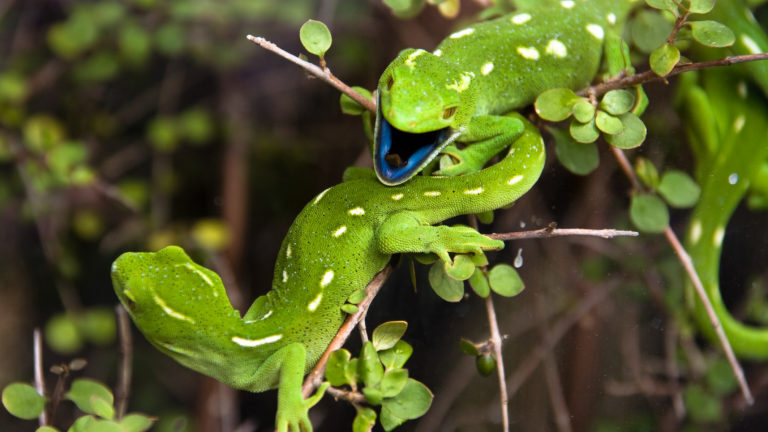
“Introductions of mammalian predators have led to extinctions or declines of many species on islands; hence eradications of these mammals have played a major role in biodiversity conservation. However, eradications are costly and sometimes controversial. It is therefore important to conduct carefully designed sampling programmes that allow benefits to native species to be quantified. We report the results of sampling conducted in 1994–1996 and 2014–2015 to estimate changes in relative abundance of lizards on Kāpiti Island over 20 years following the eradication of Norway rats (Rattus norvegicus) and kiore (Rattus exulans) in 1996.”
Before humans arrived – with mammal predators in tow – lizards were widespread, living in a range of different ecosystems and playing important functional roles as both prey and predators, as well as being pollinators and seed dispersers for our native plant species. But land modification and predation have reduced numbers and impacted distribution of lizards, driving some species to extinction and isolating other populations in greatly restricted ranges.
Kiore were the first rodents to have an impact.
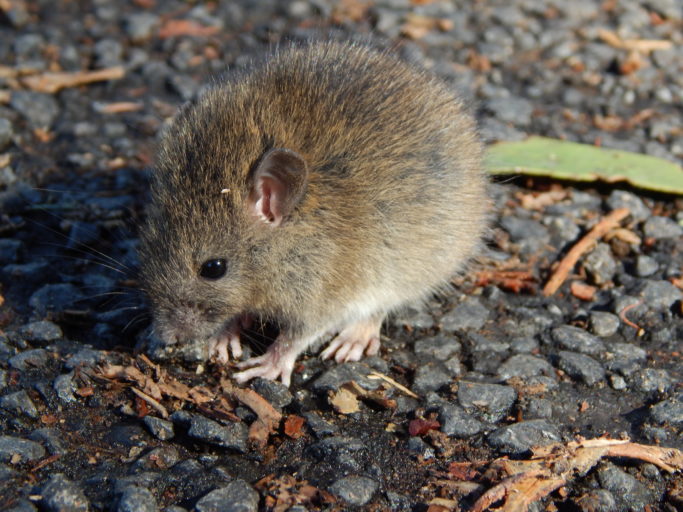
“Through comparison of islands, Whitaker (1973, 1978) documented that both abundance and diversity of lizards was reduced when kiore (Rattus exulans) were present, with these islands typically having two to three fewer species than expected. He also documented that the effect of kiore differed among lizard species, with some severely impacted while others seemed to be unaffected. Such impacts may be due to both predation and competition, as kiore would have reduced fruit and invertebrates that lizards would have fed on as well as directly preying on lizards.”
“Prior to their eradication, Norway rats and kiore were both found year-round in all habitats sampled in our study, with the highest, but most variable capture rates in coastal grassland and kānuka forest while more stable, lower-density populations were found in forested habitats. Norway rats were estimated to have higher density than kiore, and both species were competitors and predators of lizards on Kāpiti. Both species’ diets are a mix of plant material, invertebrates, and vertebrates. Stomach samples from Kāpiti suggested that invertebrates dominated the kiore diet and seed dominated the Norway rat diet, but skink remains were found in both species.”
Kiore along with Norway rats were removed from Kāpiti Island in 1996. But mammal eradications began much earlier in the sanctuary’s history.
“Kāpiti is a 1965-ha island 5 km off the west coast of the lower North Island which was originally dominated by mature coastal and podocarp-mixed broadleaf forest. It has been occupied by Māori for many centuries, resulting in some vegetation impacts and introduction of kiore. Following European arrival, most of the forest was cleared for farming and the island was colonised by Norway rats, cats, brush-tailed possums, feral cattle, goats and sheep. Most of Kāpiti was designated a sanctuary in 1897 and mammal eradications began in 1902. The final eradications occurred in 1996 when the two rat species were removed through an aerial poison operation.”
In order to monitor how lizard populations are recovering, the researchers carried out sampling in five different habitats over the island – high forest, coastal forest, coastal grassland, kānuka forest and ridge grassland habitats.
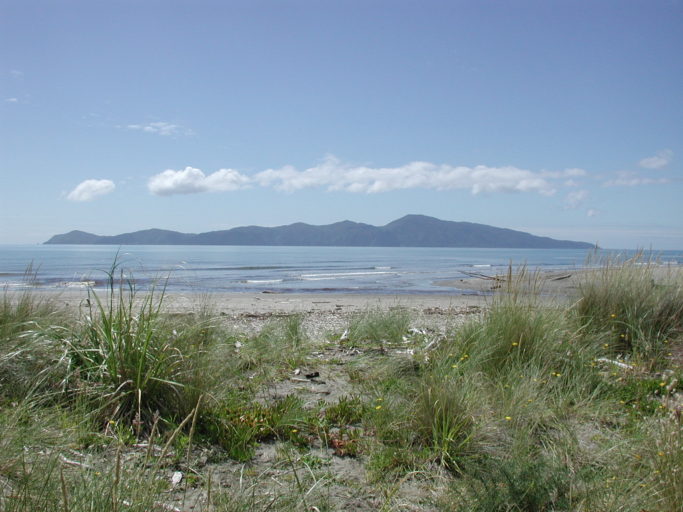
“Kāpiti consists mostly of hilly terrain, which by 1996 was dominated by regenerating forest and shrubland, with abundant kohekohe, kānuka , tawa and whauwhaupaku (five-finger). There are also three flat areas of grassland, and areas dominated by tussock and flax (harakeke and wharariki) totalling about 60 ha. Each habitat involved repeatedly sampling 4–5 pitfall stations (five pitfall traps each) and conducting spotlighting and daytime searches along 2–3 transect lines.”
Changes in vegetation cover between 1994-1996 and 2014-2015 were also recorded, to see whether changes in lizard counts could be attributed to changes in vegetation.
“The five pitfall traps in each station consisted of a central pitfall trap with the rest placed in a cross formation 4 m from the central pitfall trap. The traps consisted of 4 litre paint tins with drainage holes cut in the bottom and were dug into the ground or into rock piles until the rim was flush with the ground surface. Small pieces of stone, wood or leaves were placed in the bottom to provide cover for lizards, and rocks or pinned-down plywood were used to cover the traps. When the traps were not set, they were left with large sticks or rocks in them to allow animals to escape. When the traps were set, the escape paths were removed and a teaspoon each of canned pear and a chicken-or fish-based cat food placed at the bottom of the pitfall trap. The traps were checked within 24 h after setting.”
Researchers searched using spotlights to detect lizards at night.
“We collected spotlighting data from each transect on two occasions in 1994–1996 and 2–3 occasions in 2014–2015. This involved slowly walking the 200-m transect over about 2 hours, starting shortly after it was completely dark. We used a head lamp and binoculars, aiming the light toward the ground, tree trunks, crevices and canopy as well as looking in shrubs and flax bushes where present. We only conducted spotlighting when vegetation was dry, as water droplets make eyeshine difficult to distinguish.”
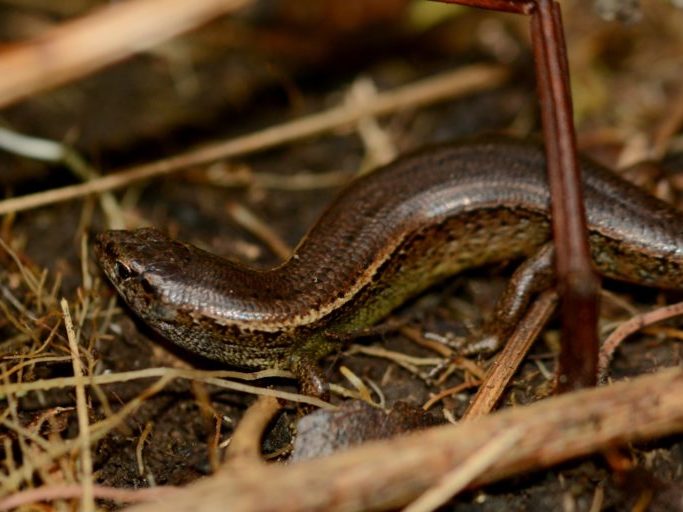
Daytime searches were carried out on days without wind and rain, when lizards were expected to be out and about.
Weather variables were also noted as weather could affect whether lizards were active.
“For each day that sampling took place, we obtained data on the maximum and minimum temperature, and relative humidity in the morning (06:00), midday and evening (18:00) from the nearest NIWA weather stations. We also scored the general weather conditions each day as: 0 = constant rain or mist, 1 = overcast with some rain, 2 = mostly cloudy, 3 = mostly fine, 4 = fine all day.”
Most skinks were found in baited pitfall traps whereas geckos were mainly found by night-time spotlighting.
“Almost all these captures were Northern grass skinks (Oligosoma polychroma) (n = 506), brown skinks (O. zelandicum) (n = 19), or copper skinks (O. aeneum) (n = 67), caught in the coastal grassland (n = 419), ridge grassland (n = 158) and kānuka forest (n = 15) habitats. A single ornate skink (O. ornatum) was caught in a baited pitfall trap in coastal forest in 2014–2015, whereas none were caught in 1994–1996. We recorded only 17 skinks in daytime searches, including 6 found in 30.8 h of searching in 1994–1996 and 11 found in 30.3 h of searching in 2014–2015. Most of these fled before they could be identified.”
“Most geckos were encountered during spotlighting (n = 129) and daytime searching (n = 25), including 69 in coastal grassland, 27 in kānuka forest, 24 in ridge grassland, 6 in coastal forest, and one in high forest. The gecko in high forest was a forest gecko (Mokopirirakau “Southern North Island”) which was found in 1994–1996. The remainder appeared to be Raukawa geckos (Woodworthia maculata), and this was confirmed for the 37 individuals that were captured. Four Raukawa geckos were captured in pitfall traps. There were also two incidental sightings of Wellington green geckos (Naultinus punctatus) in 2014–2015, one in the kānuka forest habitat and the other by the lodge at the north end of the island.”
Some species increased almost 30-fold over the 20-year period that Kāpiti was rat-free.
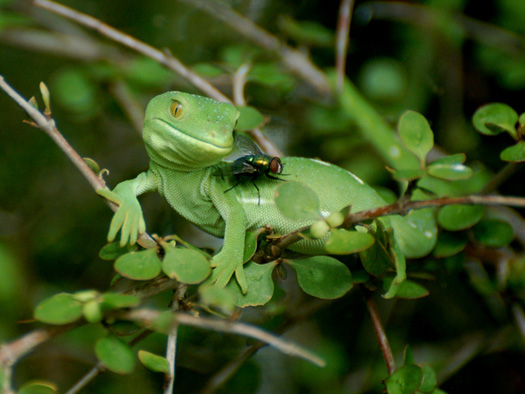
“Pitfall capture rates for northern grass skinks (Oligosoma polychroma), brown skinks (Oligosoma zelandicum), and copper skinks (Oligosoma aeneum) were estimated to increase 2- to 28-fold in habitats where they were detected in 1994–1996, and these species were also found in 2014–2015 in habitats where they were not detected in 1994–1996. Spotlighting encounter rates for geckos (predominantly Raukawa geckos, Woodworthia maculata) were estimated to increase 3.7-fold between the two time periods.”
Other species remain quite rare – or at least rarely seen.
“There were sparse observations of ornate skinks (Oligosoma ornatum), forest geckos (Mokopirirakau granulatus) and Wellington green geckos (Naultinus punctatus), whereas goldstripe geckos (Woodworthia chrysosiretica), which were discovered on the island in 2013, were not detected in the areas sampled.”
There were clear changes in vegetation cover too.
“The key vegetation change from 1994–1996 to 2014–2015 was a marked increase in large herb cover at almost all pitfall stations. There was a corresponding reduction in ground cover at the coastal grassland and ridge grassland stations, but not in kānuka forest. Changes in other layers were minor, but there was a tendency for shrub cover to increase in all habitats and tree cover to reduce in kānuka forest.”
Bird predators of lizards remain on Kāpiti Island – including weka.
“Most lizards continue to be found in habitats with low, dense vegetation, a pattern that may be at least partially attributable to predation pressure from the abundant weka on the island. Weka are known to be predators of ground-nesting birds, lizards, insects and snails, leading to their eradication from many New Zealand islands.”
“They are seen actively foraging on Kāpiti day and night, frequently turning over cover such as leaf litter and beach wrack. We observed weka foraging in all the habitats sampled in this study, but especially in the forested habitats, potentially explaining the scarcity of ornate skinks in coastal forest and high forest, and the scarcity of other skinks in kānuka forest. In addition, skinks are likely to be much more vulnerable to weka predation in forest than in the grassland habitats where the dense ground vegetation offers protection.”
If other, rare lizard species are reintroduced to Kāpiti in future, the authors suggest the introductions may need to be carried out in weka-proof enclosures.
“While all of these species will have co-existed with weka and other avian predators in the past, to establish new populations in the presence of weka may require secure habitat large enough to support a sustainable population as an ongoing source of dispersal.”
The full article is published in the New Zealand Journal of Ecology and is freely available online.

